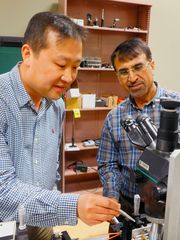
LAS CRUCES – Unseen by the human eye, yet everywhere within our environment, electromagnetic fields are largely ignored by most of us. But these constantly changing electrical fields are very important for the people at White Sands Missile Range (WSMR) who are responsible for field testing electronic hardware that may be crucial to our national defense.
New Mexico State University Electrical Engineering Associate Professors Muhammad Dawood and Sang-Yeon Cho, along with Assistant Professor of Computer Science Phoebe O. Toups Dugas, are setting out to help improve the data accuracy of field tests conducted on electronic hardware at WSMR. The missile range is charged with providing the U.S. Department of Defense, our military forces and other customers with field and laboratory evaluation of systems, materiel and equipment. Throughout its history, White Sands has tested a wide variety of hardware, including air defense missile systems, surface-to-surface rocket/missile systems, and various unmanned aerial vehicles.
The NMSU researchers, who have received a three-year grant from WSMR, are tackling a two-pronged problem: First, the inability to acquire accurate field measurements, and second, the difficulty for the people scheduling tests to avoid conflicts. Electromagnetic fields are areas of energy emitted by natural and human-made sources. The Earth’s own magnetic field is used by birds and fish for navigation. Thunderstorms cause a build-up of electric charges in the atmosphere. The electromagnetic spectrum also includes human-generated sources, such as power lines, electrical wiring, microwave ovens, computers and cell phones. Add to that a number of White Sands’ antennas radiating from 10 KHz to 40GHz, multiple real-time projects being tested, along with various buildings and desert topography, which cause interference. Electromagnetic fields can get muddled, making them difficult to measure accurately. “WSMR has the responsibility to test instruments and equipment for the DoD before they purchase or deploy that equipment to our soldiers in the field,” said Dawood. “For example, WSMR might be testing a hand-held communications device for Army troops to use in the field. A prototype would be tested for performance.”
Current measurement technologies actually distort the distribution of the electromagnetic field of the nearby region. The first goal of this project, being investigated by Cho, is to develop an electro-optic probe capable of taking measurements without disturbing the field itself. “Certain crystals can change the propagation direction of light when an electromagnetic field is applied. An optical circuit integrated with an electro-optic crystal will be developed to measure the distribution of the electromagnetic field,” explained Cho. “Unlike existing electrical circuits, optical circuits are transparent to electromagnetic fields radiated by radio-frequency antennas and have also been demonstrated to be highly sensitive and reliable.”
A second part of the project, led by Dawood, will focus on mathematically modeling the electro-magnetic field. Ordinarily an easy task in free space, this becomes complicated when antennas are operated in close proximity to buildings and other man-made structures, as well as the varied geographic topology. Dawood will develop a method to generate electro-magnetic spectrum models that include the physical position of antennas, and their location in relation to buildings, hills and other diverse nearby topology on the range.
Dawood notes that there are some challenges to this project. “One is sparsity of existing data. There is no theoretical data available about modeling electromagnetic fields of some of the existing structures in this environment. Another is access to the facility and its personnel — this type of testing is restricted to civilians. A third challenge is weather and our harsh environment. We don’t know how extreme summer heat or our monsoon season will affect the data.”
Toups Dugas will then combine Cho’s sensor data and Dawood’s numeric models with a Geospatial Spectrum Visualization tool to generate a 3-D map, ultimately to be displayed on a large computer monitor. Complex field data would be displayed with color and other visual cues, making it easier for schedulers to detect and predict potential conflicts for testing. This would provide schedulers with real-time awareness of the electromagnetic field and changes as they occur, optimizing use of the range for field testing.
“My understanding is that, as it turns out, much of the work of scheduling tests is done by hand with minimal technological support. Experts rely on experience to determine what tests might impact others. Using Professor Dawood’s models, we should be able to more accurately inform human decision makers about what tests will conflict across space and time. The intent is to improve the density of tests at the range, so that more can be done in less time,” said Toups.
“White Sands tests high-precision devices to replicate actual scenarios of how they would be used in the field,” explained Dawood. “This requires exact measurements that show the stresses and durability of the instruments to assure that they are ready to be used by our soldiers in the field.”
“Eye on Research” is provided by New Mexico State University. This week’s feature was written by Linda Fresques of the College of Engineering.
